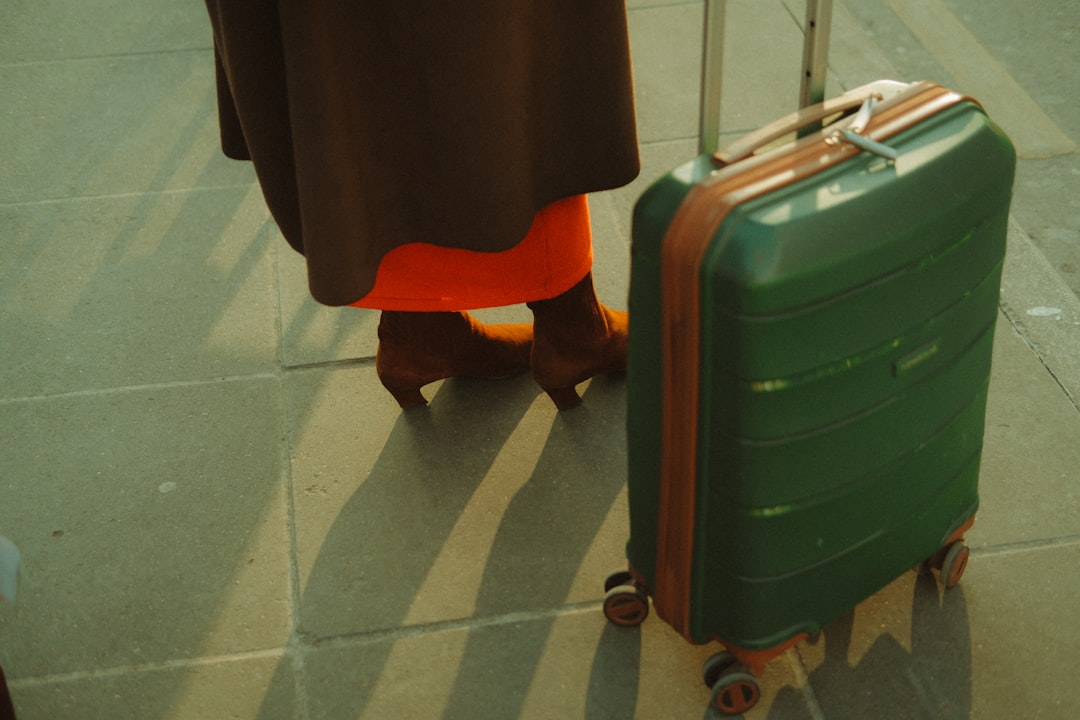Why Smart Packing Makes or Breaks Your European Adventure
Figuring out what to pack for a Europe trip can be overwhelming, but getting it right is the key to a stress-free adventure. Smart packing means you can comfortably explore cobblestone streets and steer busy train stations without being weighed down by a heavy suitcase. Here’s what you absolutely need:
Essential Packing Categories for Europe:
- Documents & Money – Passport, visas, travel insurance, and a mix of cards and cash.
- Luggage – A versatile carry-on and a secure daypack are often all you need.
- Clothing – Think layers and multi-purpose items.
- Shoes – Comfort is king. Prioritize supportive walking shoes.
- Toiletries & Health – Travel-sized essentials and a basic first-aid kit.
- Electronics – Don’t forget your universal adapter and a power bank.
Europe is a continent of diverse climates and cultures. What works for a beach holiday in Greece won’t work for a winter trip to Norway. Europeans also tend to dress a bit more formally for daily activities, so it’s wise to leave the gym wear at home. The biggest packing mistakes are overpacking, especially shoes, and not being prepared for different weather or airline luggage rules.
I’m Ramy Saber, founder of GoTravelHunt, and I’ve learned from years of travel that a well-packed bag is the foundation of a great trip. This guide will help you pack efficiently, ensuring you’re ready for anything your European adventure throws your way.
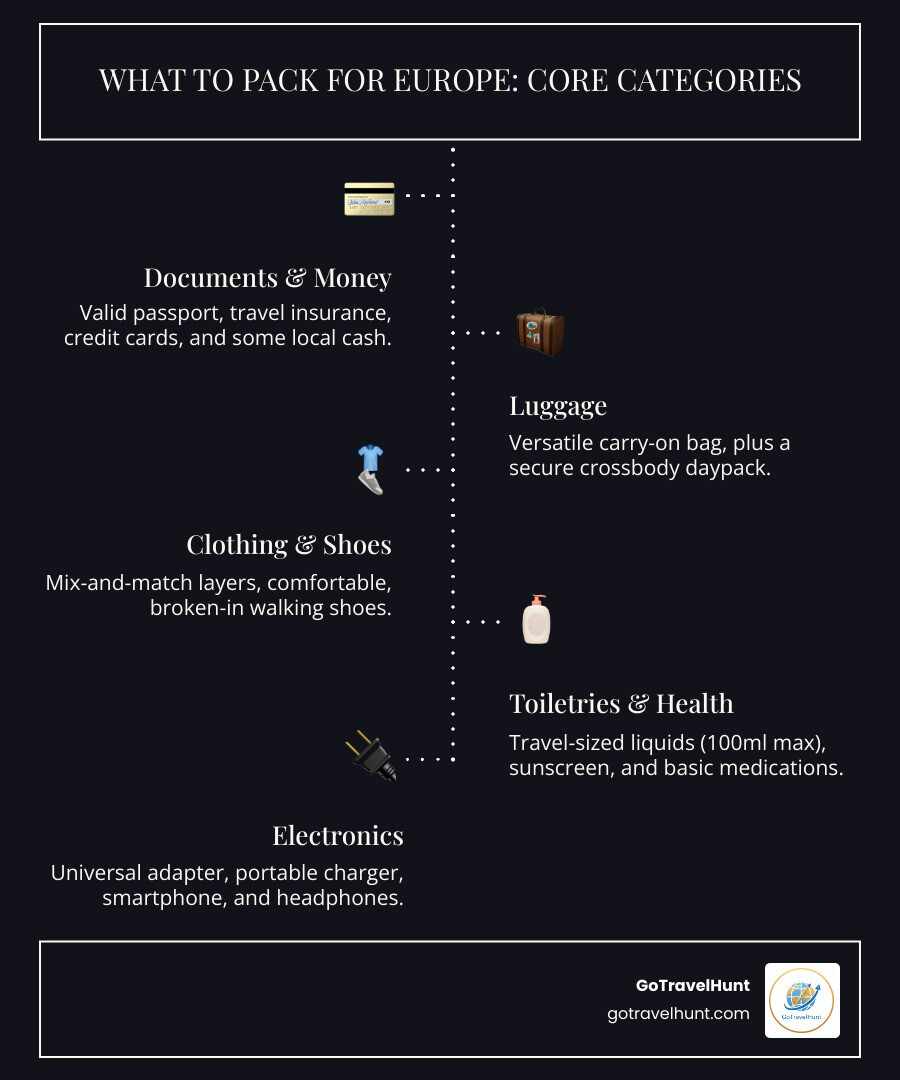
Basic what to pack for europe trip terms:
- hidden bucket list ideas
- last minute packing list
- packing checklists
The Foundation: Documents, Money, and Luggage
Getting your essentials in order is the first step to a seamless European adventure.
Travel Documents & Security
- Passport: Ensure your passport is valid for at least six months beyond your intended departure date. This is a strict requirement for many countries.
- Visas: Check the visa requirements for your nationality and all destinations. The Schengen Zone allows visa-free travel for up to 90 days for many, but countries outside this zone (like the UK) have their own rules.
- Copies: Keep digital and physical copies of your passport, visa, and travel insurance. Store them separately from the originals.
- Travel Insurance: This is non-negotiable. It protects you from unexpected medical emergencies, trip cancellations, or lost luggage. For help, find the right European travel insurance.
- Reservations: It’s wise to have printed copies of your flight, train, and hotel bookings in case of a dead phone battery. To keep everything organized, create your perfect travel itinerary.
Managing Money in Europe
- Cards: Use credit and debit cards with no foreign transaction fees to save money. Inform your bank of your travel dates to avoid your cards being frozen.
- Cash: While Europe is largely cashless, it’s smart to carry €100-€200 in local currency for small shops, markets, or tips. Not all European countries use the Euro.
- ATMs: Withdraw cash from ATMs at reputable banks for better exchange rates. Avoid airport currency exchange kiosks, which often have high fees.
- Tap-to-Pay: Contactless payments via phone or card are widely accepted and very convenient.
Choosing the Right Luggage
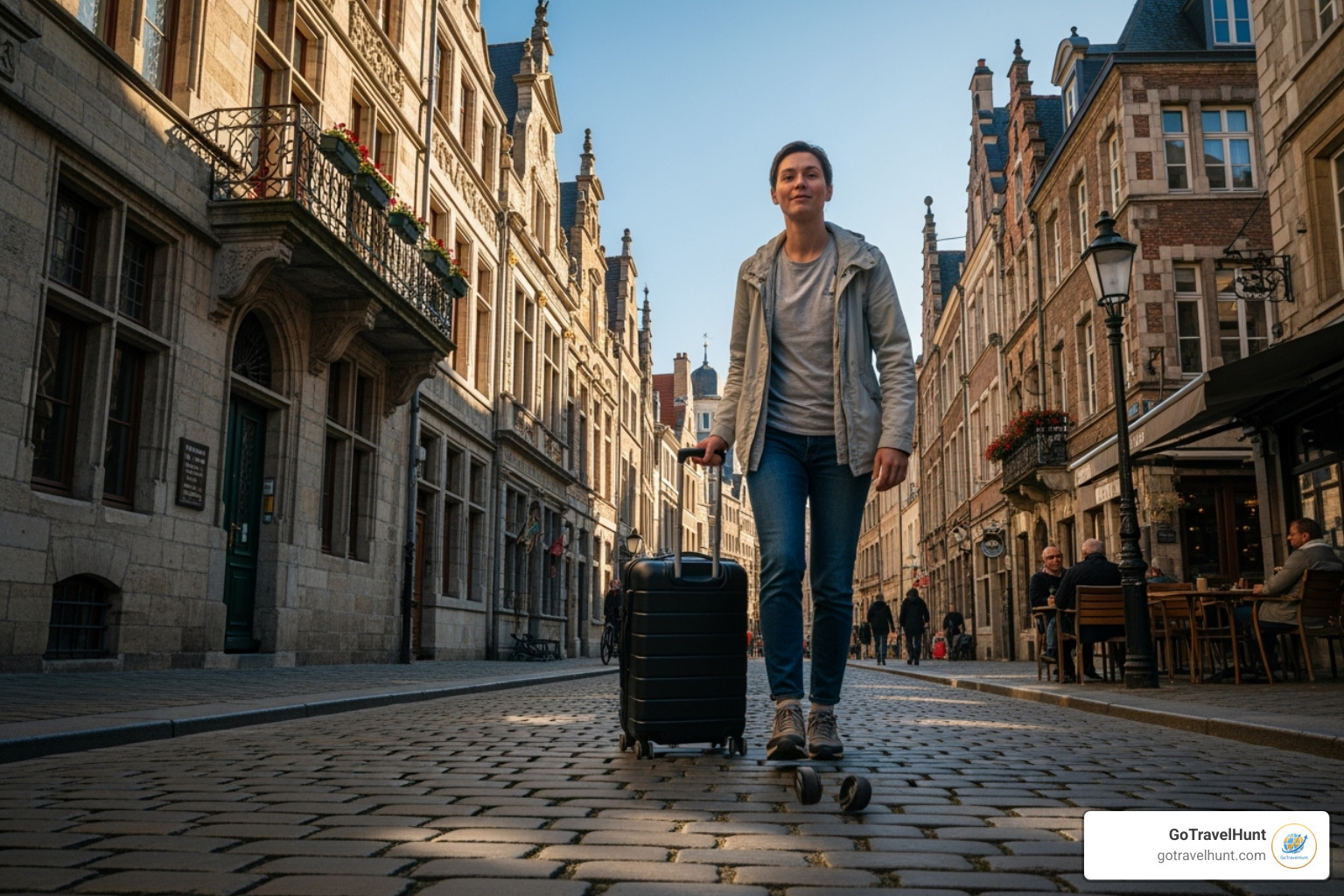
Europe’s charming cobblestone streets and old buildings with no elevators make luggage choice critical.
- Carry-On vs. Checked: For trips of two weeks or less, a carry-on is highly recommended. It saves time, eliminates the risk of lost luggage, and is much easier to manage on public transport.
- Airline Rules: Be aware that European budget airlines like Ryanair and EasyJet have very strict and small hand luggage allowances. Always check their websites for the latest size and weight restrictions to avoid hefty fees at the gate.
- Backpack vs. Suitcase: A backpack or a convertible bag that can be carried on your back is often more practical than a wheeled suitcase for navigating stairs and uneven surfaces.
- Daypack: A secure daypack or crossbody bag is essential for your daily excursions. It keeps your wallet, phone, and other valuables safe and accessible. For more tips on packing light, check out our city break packing list.
The Ultimate Europe Packing Checklist: Clothing, Shoes & Accessories
Europeans are known for their style, but comfort is paramount when you’re exploring. Here’s how to balance both.
Essential Clothing for What to Pack for a Europe Trip
When deciding what to pack for a Europe trip, focus on versatile layers that can be mixed and matched. Europeans tend to dress up more, so leave the overly casual or athletic wear at home.
- Tops: 4-5 mix-and-match options, including both short and long-sleeved shirts.
- Bottoms: 2-3 versatile pairs, such as dark-wash jeans, trousers, or a skirt.
- Layers: 1-2 sweaters or cardigans for chilly evenings or air-conditioned museums.
- Outerwear: A classic, weather-appropriate jacket (like a trench coat or light blazer) and a compact umbrella or rain jacket are essential.
- Dressy Option: One smart outfit for nicer dinners or events.
Pro-Tip: Stick to a neutral color palette (black, grey, navy, beige) and wrinkle-resistant fabrics to maximize your outfit combinations and minimize time spent ironing.
The Best Shoes for European Terrains
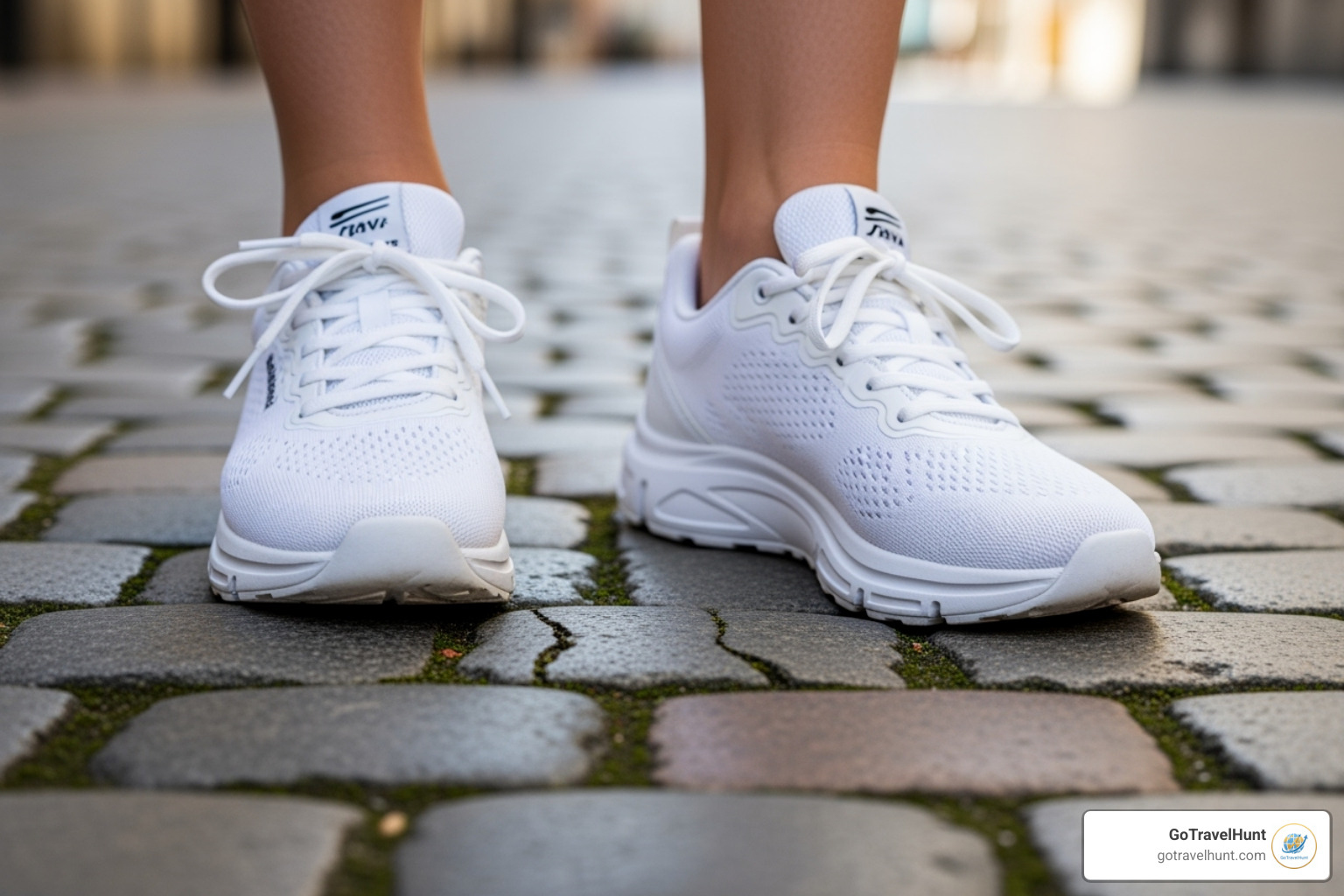
You will walk a lot, often on uneven cobblestone streets. Comfortable footwear is non-negotiable.
- Break Them In: Never travel with brand-new shoes. Wear them for a few weeks before your trip to avoid painful blisters.
- Comfortable Walking Shoes: One pair of stylish, supportive sneakers is your most important item. Brands like Ecco or Allbirds offer great options that blend comfort and style.
- Versatile Second Pair: Pack one pair of versatile flats or ankle boots for evenings or dressier occasions.
- Sandals (Seasonal): For summer trips, include a pair of supportive sandals. Avoid flimsy flip-flops, which are not suitable for city walking.
Smart Accessories to Lift Your Wardrobe
Accessories are a lightweight way to transform your outfits and add a touch of personal style.
- Scarf: A versatile scarf can add color, provide warmth, or serve as a head covering for religious sites.
- Jewelry: A few simple, non-valuable pieces are best.
- Hat & Sunglasses: Essential for sun protection and a chic look.
- Belt: A simple belt can cinch a dress or polish a casual outfit.
What to Pack for a Europe Trip: Toiletries, Health & Electronics
From staying healthy on the road to keeping your devices charged, these essentials are crucial for a modern traveler.
Toiletries and Personal Care
European airports are strict about the 100ml (3.4oz) liquid limit for carry-on luggage. All liquids must fit in a single, clear, quart-sized bag.
- Travel-Sized Everything: Decant your favorite products into reusable travel-sized containers or buy solid toiletries like shampoo bars and toothpaste tabs to save space and avoid spills.
- Must-Haves: Don’t forget sunscreen (a year-round essential), a basic makeup kit, and a reusable water bottle. Tap water is safe to drink in most of Europe, and you can find refill stations in many cities.
- Hanging Toiletry Bag: A lifesaver in small European hotel bathrooms where counter space is often limited.
Your Travel Medical Kit
A small, well-stocked medical kit can prevent minor issues from disrupting your trip.
- Prescription Medications: Keep these in your carry-on in their original bottles, along with a copy of your prescription.
- Over-the-Counter Basics: Pack pain relievers (ibuprofen, paracetamol), band-aids, antiseptic ointment, and hand sanitizer.
- Other Useful Items: Consider bringing allergy medication, motion sickness tablets, and eye drops. Earplugs and an eye mask are also great for ensuring a good night’s sleep.
- Official Health Advice: Before you go, check for any health advisories for your destination. A good resource is the UK’s Fit for Travel site.
Electronics and Gadgets: What to Pack for a Europe Trip
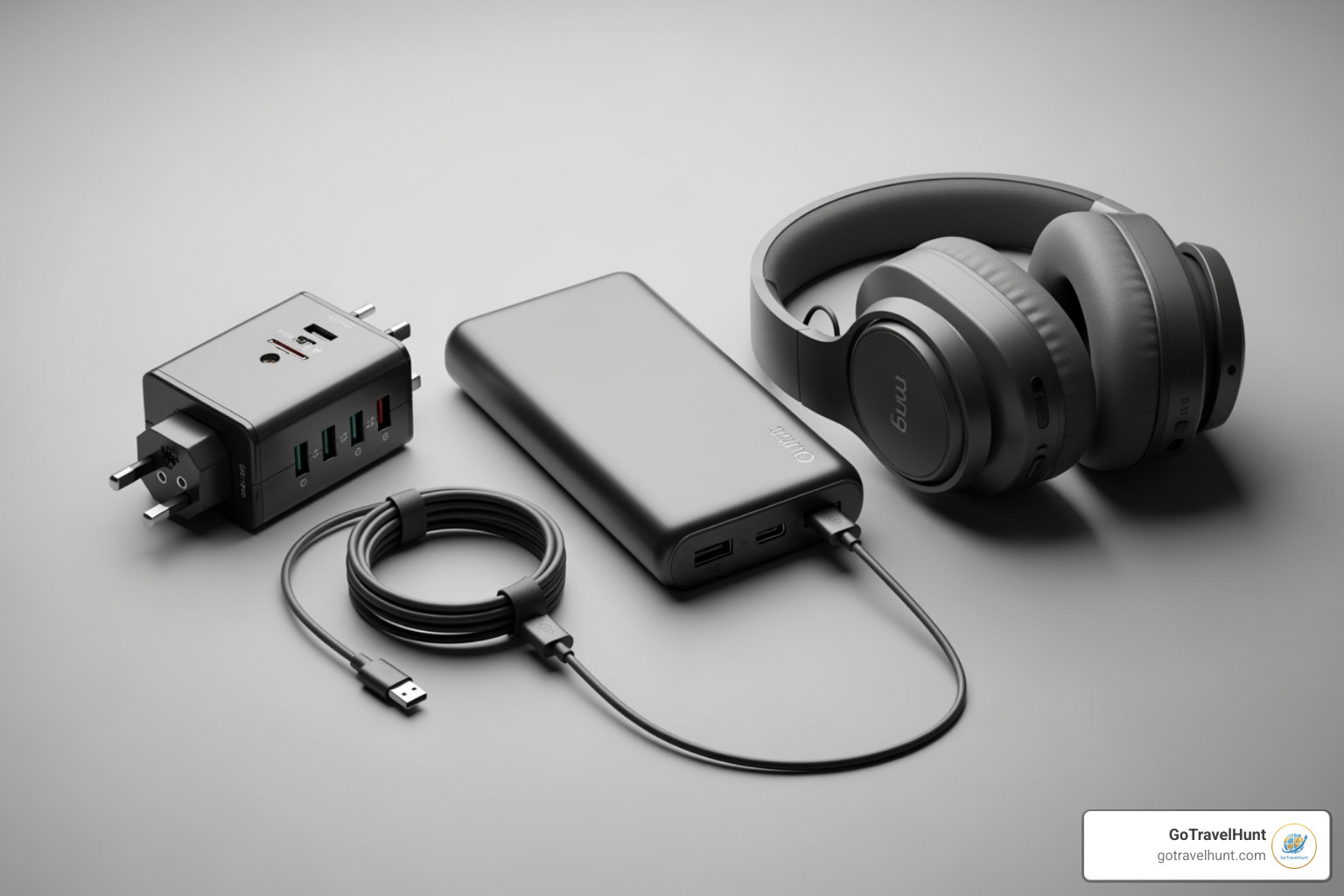
Keeping your devices charged and ready is key for modern travel.
- Universal Travel Adapter: This is non-negotiable. The UK and Ireland use a different plug type than mainland Europe. A universal adapter ensures you’re always prepared. Also, check if you need a voltage converter for high-power items like hair dryers, as European voltage (220-240V) is higher than in North America (110-120V).
- Portable Charger (Power Bank): Your phone will be your map, camera, and translator. A power bank is essential to keep it running all day.
- Smartphone Prep: Download offline maps and translation apps before you leave to save on data.
- Entertainment: An e-reader and noise-canceling headphones are perfect for long flights and train rides.
- AirTags: For peace of mind, place a tracker like an AirTag in your checked luggage and daypack.
- Portable Fan: A small, handheld fan can be a lifesaver during summer, as air conditioning is not as common in Europe as it is in the US.
Smart Packing Strategies for Any European Itinerary
Master the art of packing with these tips for different seasons, regions, and travel styles.
Packing for Europe’s Seasons and Regions
Europe’s climate varies dramatically, so what you pack depends on when and where you’re going. Always check the forecast for your specific destinations before you leave.
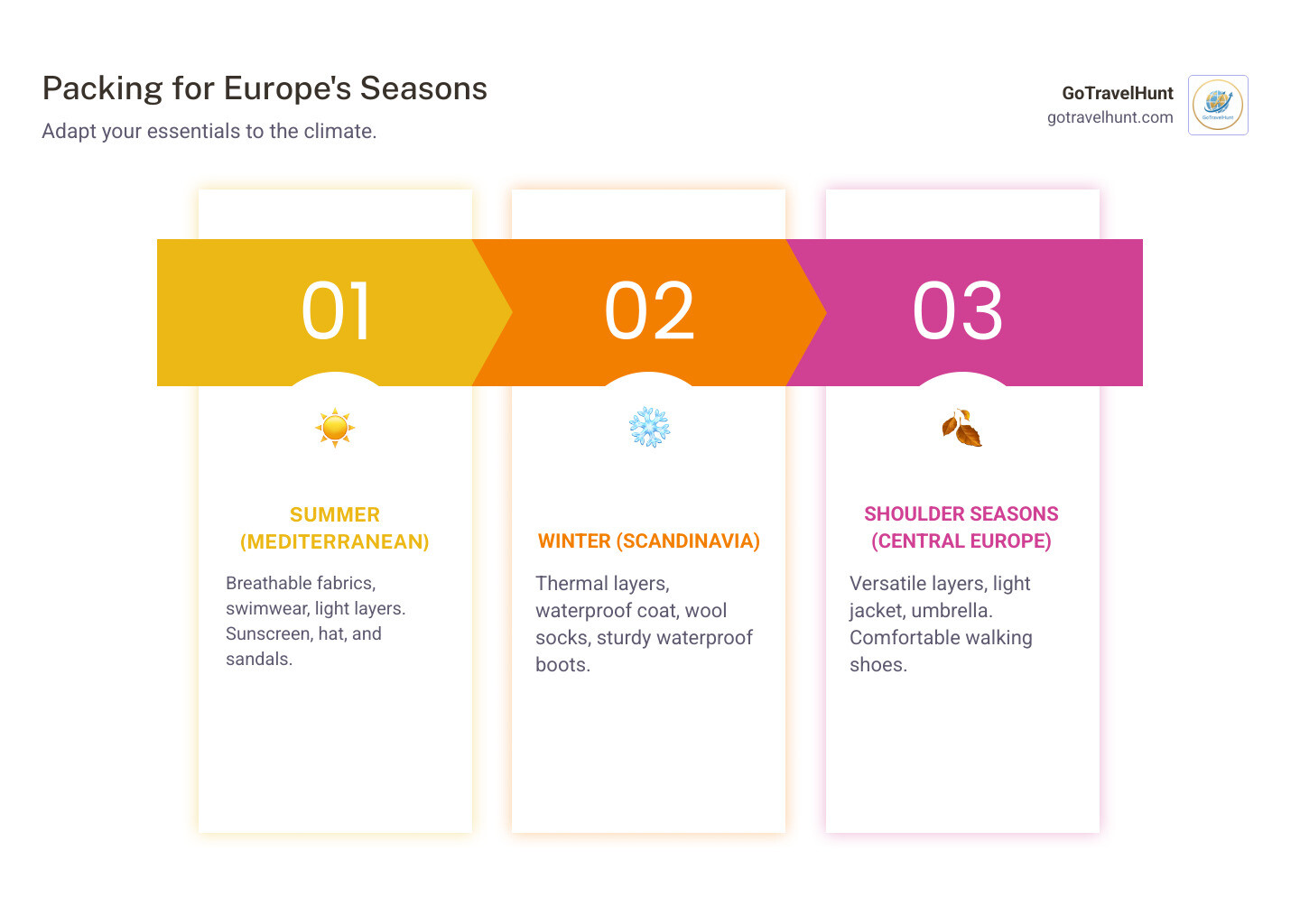
- Summer (Mediterranean): Think hot and sunny. Pack lightweight, breathable fabrics like cotton and linen, swimwear, a wide-brimmed hat, and high-SPF sunscreen.
- Winter (Scandinavia & Central Europe): Prepare for the cold. Thermal base layers, a waterproof and insulated coat, wool socks, waterproof boots, gloves, a scarf, and a hat are essential.
- Spring & Autumn (Shoulder Seasons): Expect unpredictable weather. Layering is key. Pack a mix of short and long-sleeved tops, a light water-resistant jacket, and a compact umbrella.
How to Pack Light and Avoid Common Mistakes
Packing light is about being strategic, not about going without. Here’s how to avoid common pitfalls:
- Use Packing Cubes: These are a game-changer for organizing your suitcase and compressing clothes to save space.
- Roll, Don’t Fold: Rolling most clothing items saves space and minimizes wrinkles. Fold more structured items like blazers.
- Avoid “Just in Case” Items: If you don’t have a specific plan to use an item, leave it at home. Every piece should be versatile.
- Leave Room for Souvenirs: Aim to pack your bag to about 80% capacity to leave space for things you buy on your trip.
- Wear Your Heaviest Items: Wear your bulkiest shoes and jacket on the plane to save precious luggage space and weight.
For more detailed packing strategies, see our best travel packing list.
Special Considerations for Your Trip
A few extra items can make your trip safer and more comfortable.
- Reusable Water Bottle: Stay hydrated, save money, and be eco-friendly. Tap water is safe to drink in most of Western Europe.
- Safety for Solo Travelers: A portable door lock and a safety whistle can provide extra peace of mind. Always trust your instincts and be aware of your surroundings. For more tips, explore our solo trip ideas.
- Preventing Theft: Use a crossbody bag worn in front of you or a money belt in crowded areas to protect against pickpockets. Consider a bag with RFID-blocking technology.
- Dietary Needs: If you have allergies, carry translation cards that explain your requirements in the local language.
The Foundation: Documents, Money, and Luggage
Choosing the right gear and getting your essentials in order is the first step to a seamless European adventure.
Travel Documents & Security
- Passport valid at least six months beyond departure; check country-specific visas (Schengen vs. non-Schengen).
- Make digital and paper copies of passport, visas, and insurance; store separately.
- Travel insurance is essential. Find the right European travel insurance.
- Keep printed copies of flights, trains, and stays. Create your perfect travel itinerary.
Managing Money in Europe
- Use cards with no foreign transaction fees and notify your bank.
- Carry a small cash buffer (about €100–€200); note not all countries use the Euro.
- Prefer bank ATMs for withdrawals; avoid airport exchange kiosks. Tap-to-pay is widely accepted.
Choosing the Right Luggage
- For trips up to ~2 weeks, go carry-on; budget airlines are strict—verify size/weight in advance.
- Backpacks excel on stairs/cobblestones; hybrids (wheels + straps) are versatile.
- Use a secure daypack or crossbody worn in front. For shorter trips, check out our city break packing list.
The Ultimate Europe Packing Checklist: Clothing, Shoes & Accessories
Europeans are stylish but practical—aim for smart, comfortable layers you can rewear.
Essential Clothing for What to Pack for a Europe Trip
- 4–5 mix-and-match tops, 1–2 sweaters/cardigans, 2–3 bottoms.
- 1 dressy outfit and 1 jacket (trench/leather or a light blazer).
- Neutral palette and wrinkle-resistant fabrics; add a compact umbrella or rain jacket.
The Best Shoes for European Terrains
- Break in shoes before travel.
- 1 pair stylish, supportive sneakers; 1 pair versatile flats or ankle boots; supportive sandals for summer.
Smart Accessories to Lift Your Wardrobe
- Scarf, minimalist jewelry, hat, sunglasses, and a simple belt to refresh outfits without adding bulk.
What to Pack for a Europe Trip: Toiletries, Health & Electronics
From staying healthy on the road to keeping your devices charged, these essentials are crucial for a modern traveler.
Toiletries and Personal Care
- Liquids/gels: max 100ml (3.4oz), all in one 1-liter clear, resealable bag.
- Use travel bottles or solid toiletries (shampoo/conditioner bars, toothpaste tabs).
- Sunscreen is essential; a hanging toiletry bag saves counter space.
- Bring a reusable water bottle and use public refill stations.
Your Travel Medical Kit
- Keep prescription meds in carry-on, in original bottles, plus copies of prescriptions.
- Basics: pain relievers, band-aids, antiseptic ointment, hand sanitizer; consider allergy/motion meds, eye drops, earplugs/eye mask.
- Check advisories at the UK’s Fit for Travel site.
Electronics and Gadgets: What to Pack for a Europe Trip
- Universal travel adapter (UK/Ireland plugs differ from mainland); high-watt devices may need a voltage converter.
- Power bank; download offline maps/translation before you go.
- E-reader and noise-canceling headphones for transit; AirTags for bags; a small portable fan helps during summer heat.
Smart Packing Strategies for Any European Itinerary
Master the art of packing with these tips for different seasons, regions, and travel styles.
Packing for Europe’s Seasons and Regions
Europe’s diverse geography means packing by season and destination.

- Summer (Mediterranean): breathable fabrics, swimwear, wide-brim hat, high-SPF sunscreen.
- Winter (Scandinavia & Central Europe): thermal base layers, insulated waterproof coat, wool socks, waterproof boots, gloves, scarf, hat.
- Spring/Autumn: mixed layers, light water-resistant jacket, compact umbrella.
How to Pack Light and Avoid Common Mistakes
- Use packing cubes; roll most items and fold structured pieces.
- Avoid “just in case” extras; wear your bulkiest items in transit; leave room for souvenirs.
- Check the forecast a few days before departure. For more strategies, see our best travel packing list.
Special Considerations for Your Trip
- Reusable water bottle (tap water is widely safe).
- Solo travelers: portable door lock and safety whistle; share your itinerary. For inspiration, explore our solo trip ideas.
- Respect dress codes at religious sites (carry a scarf/shawl). Hostels: bring a small padlock.
The Foundation: Documents, Money, and Luggage
Choosing the right gear and getting your essentials in order is the first step to a seamless European adventure.
Travel Documents & Security
Your passport should be valid for six months beyond departure. Check visa rules (Schengen vs. non-Schengen), make digital/physical copies of key documents, and carry travel insurance. For coverage, find the right European travel insurance. Keep printed reservations too; to stay organized, create your perfect travel itinerary.
Managing Money in Europe
Use fee-free cards and notify your bank. Carry €100–€200 in local currency (not all countries use the Euro). Prefer bank ATMs and avoid airport exchanges. Tap-to-pay is common.
Choosing the Right Luggage
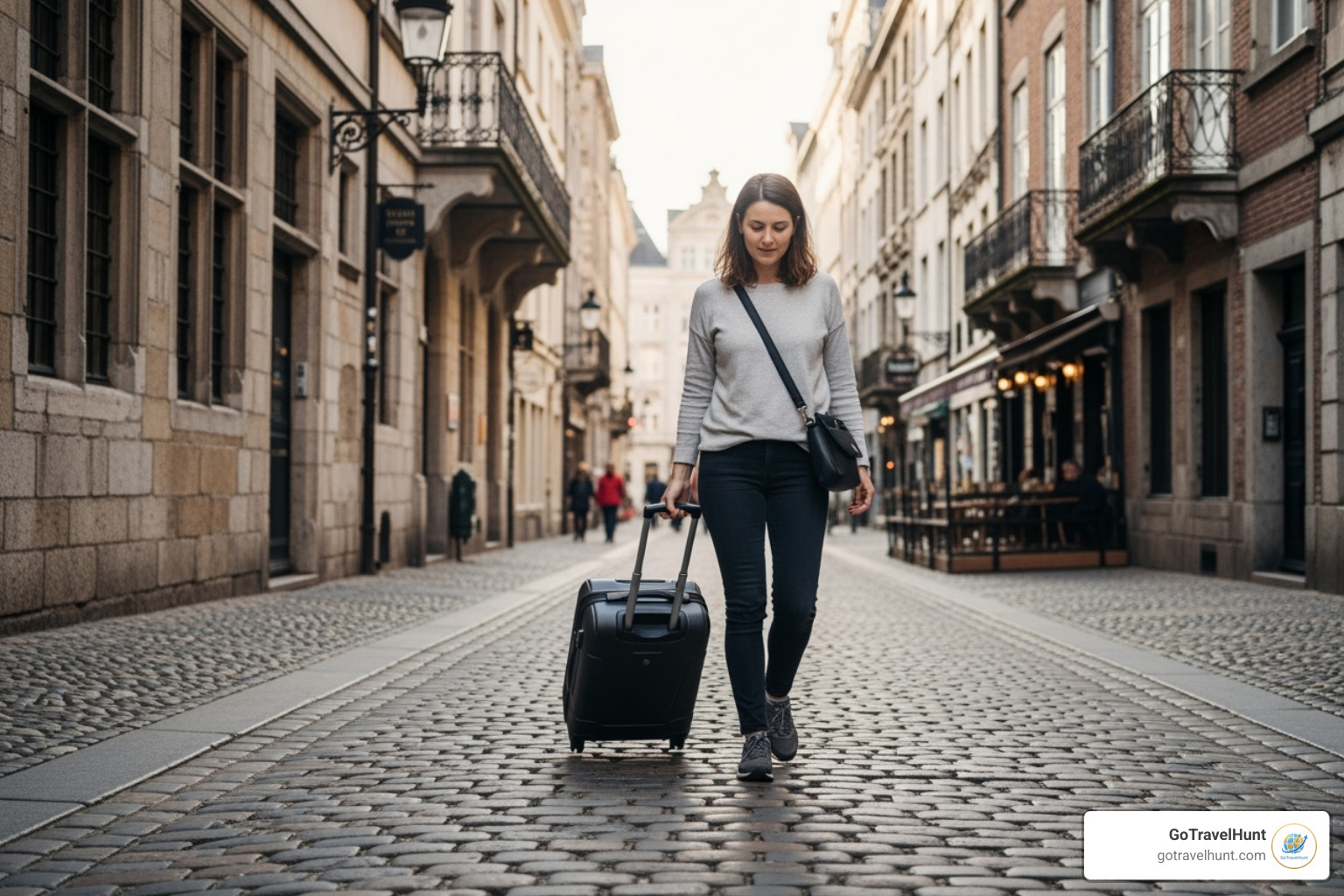
Go carry-on when possible and check strict budget-airline limits. Backpacks or hybrids handle stairs/cobblestones better than spinners. Use a secure daypack or crossbody worn in front. For short trips, check out our city break packing list.
The Ultimate Europe Packing Checklist: Clothing, Shoes & Accessories
Europeans are stylish yet practical—pack smart layers you can rewear.
Essential Clothing for What to Pack for a Europe Trip
- 4–5 tops, 1–2 sweaters/cardigans, 2–3 bottoms, 1 dressy outfit, 1 jacket.
- Favor neutrals and wrinkle-resistant fabrics; include a compact rain layer.
The Best Shoes for European Terrains
- Break in shoes. Bring 1 pair stylish, supportive sneakers; 1 pair flats or ankle boots; summer sandals if needed.
- Avoid athletic/gym shoes for nicer restaurants or theaters.
Smart Accessories to Lift Your Wardrobe
- Scarf, minimalist jewelry, hat, sunglasses, and a belt to vary outfits with minimal space.
What to Pack for a Europe Trip: Toiletries, Health & Electronics
From staying healthy on the road to keeping your devices charged, these essentials are crucial for a modern traveler.
Toiletries and Personal Care
Europe enforces the 100ml (3.4oz) liquid rule for carry-ons; all items must fit in a single 1-liter clear bag. Use travel bottles or solid toiletries. Bring sunscreen, a basic makeup kit, a hanging toiletry bag, and a reusable water bottle for refill stations.
Your Travel Medical Kit
Keep prescription meds in original bottles in your carry-on, plus copies of prescriptions. Pack pain relievers, band-aids, antiseptic ointment, hand sanitizer, and consider electrolytes, eye drops, insect repellent, motion-sickness tablets, earplugs, and an eye mask. Check advice at get official travel health advice for Europe.
Electronics and Gadgets: What to Pack for a Europe Trip
Bring a universal travel adapter (UK/Ireland plugs differ from mainland). High-watt devices may need a voltage converter. Carry a portable charger, download offline maps and translation, and consider an e-reader, noise-canceling headphones, AirTags, and a small portable fan for summer.
Smart Packing Strategies for Any European Itinerary
Master the art of packing with these tips for different seasons, regions, and travel styles.
Packing for Europe’s Seasons and Regions
- Summer (Mediterranean): lightweight cotton/linen, swimsuit, hat, sunscreen; smart-casual over gym wear.
- Winter (Scandinavia): thermal base layers, windproof/waterproof coat, wool socks, insulated waterproof boots, gloves, scarf, beanie.
- Spring/Autumn (Central Europe): layered outfits, light to medium water-resistant jacket, compact umbrella, closed-toe shoes for rain.
Check city-specific forecasts a week before departure and adjust.
How to Pack Light and Avoid Common Mistakes
Use packing cubes; roll casuals and fold structured pieces. Limit shoes (max three pairs). Pack to about 80% to leave room for souvenirs and wear bulky items on the plane. Verify weather and avoid overpacking toiletries. For more tips, see our best travel packing list.
Special Considerations for Your Trip
Carry a reusable water bottle. Solo travelers may want a portable door lock and whistle; share your itinerary and trust your instincts. Use crossbody or anti-theft bags and keep valuables secure; a money belt can help in crowded areas. Bring translation cards for dietary needs. For inspiration, explore our solo trip ideas.

